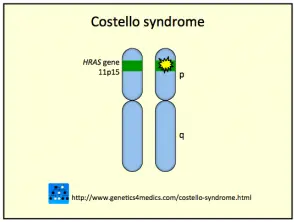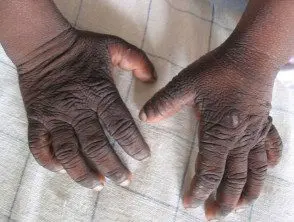What is Costello? syndrome?
Costello syndrome is a rare genetic condition in which affected individuals have a distinct, curly facial appearance hair, loose skin, heart abnormalities, and cognitive delay.
Costello syndrome is also known as faciocutaneous-skeletal syndrome.
What causes Costello syndrome?
Costello syndrome is a RASopathy. results from a paternal origin heterozygous germ line mutation of the HRAS gene present in chromosome 11p15.5. the mutations are restricted to a narrow spectrum at the p.Gly12Ser residue of HRAS. HRAS normally controls cellular differentiation and function.
- One mutation results in uncontrolled hyperactivity of RAS mitogen-activated protein kinase (MAPK) due to lack of normal suppression by RAS. HRAS.
- This leads to the growth of benign and evil one tumors
- Phenotypic Variation may be seen due to other modifying factors.
- Germline Mutations are seen in most people with Costello syndrome, while somatic mutations with a loss of heterozygosity are associated with malignant tumors.
Costello syndrome usually results from a de novo mutation, so there is no family history of the disorder. Men and women are affected equally [1–8].
Genetics of Costello syndrome

Costello syndrome
* Credit: Genetics 4 Doctors.
What are the clinical features of Costello syndrome?
The symptoms of Costello syndrome evolve over a period of time, and developmental delay is common. The key clinical features are:
- Macrocephaly (large head) and macrosomia (large body) at birth
- coarse facial features
- hypoglycemia (low blood sugar)
- feeding difficulties and postnatal growth retardation
- Unexplained tachyarrhythmia (elevated heart rate)
- Hypotonia (low muscle tone)
- Hoarsely.
Perinatal features may include:
- premature labor
- Excessive amniotic fluid in the uterus (leading to conditions such as hydrops and polyhydramnios)
- Macrosomia with nuchal thickening
- Short and long bones and abnormal hand posture.
- Cardiac and renal abnormalities in a prenatal scan
- Fetal tachyarrhythmia
- Lymphatic dysplasia.
Hyperpigmentation Skin with deep folds and loose skin on the hands and feet should increase the clinical suspicion of Costello syndrome during childhood. Other features that may occur throughout the patient's life may include:
- Characteristic facial features:
- Macrocephaly with high forehead
- bitemporal narrowing
- Large cupped, posteriorly rotated ears with folded earlobes
- A flat nasal bridge with epicanthic folds
- A square mandible with a pointed chin
- a prominent tongue
- Full cheeks and lips with a wide mouth.
- Characteristic features of the hands:
- Hypermobile with ulnar deviation
- Extended fingers with spatulate tips
- Orthopedic problems:
- A short neck curve and inverted neck (cervical kyphosis)
- spinal abnormalities
- Thoracic deformity with asymmetry of the sternum and rib cage
- Joint laxity with positional foot deformity
- Narrow Achilles tendon.
- Characteristic changes in skin, hair, and nails (detailed below)
- Short stature
- relative macrocephaly
- difficulty eating
- Developmental disabilities [1–9].
Costello syndrome

Costello syndrome
What are the dermatological manifestations of Costello syndrome?
Ectodermal defects involving skin, hair, nailand mucous membrane The changes are common and often distinctive.
Skin
The main dermatological manifestations of Costello syndrome may include:
- Velvety soft and redundant skin on the neck, hands and feet.
- Hyperkeratosis of palms and soles, and calluses on dorsal aspects of the hands and feet
- Loose skin with deep palm and plant folds
- Distal folds of the fingertips with pachydermatoglyphics and dotted dermatoglyphics (fingerprints) that evolve with age
- Pachydermatoglyphia, seen clinically as an exaggerated pattern of ridges on the palms and fingertips and histologically as marked epidermal hyperkeratosis acanthosis, papillomatosisand hypergranulosis
- Periorificial papillomas in perinasal, perioral and perianal areas; these can also be seen on the torso, limbs and armpits; papillomas that appear as skin tags or sessile nodules they can also be viral warts or keratosis and these typically manifest after infancy
- Pachydermatoglyphia, malignant acanthosis nigricans, and flowery cutaneous papillomatosis occurring in the same patient may suggest a deregulation of transformation growth factorAlpha or epidermal growth factor.
Nail
Nail defects in Costello syndrome manifest as brittle, triangular, slow-growing dystrophic nails with longitudinal striae.
Hair
Hair changes in Costello syndrome may include:
- Hair that can be blonde or pigmented, but different in type from that of other members of the family
- Fine, curly hair with tight curls that give a frizzy “cloud of curls” appearance
- Thick eyebrows and unusually long eyelashes, sometimes requiring regular trimming.
Alopecia can be seen, but this is a more common feature in cardiofaciocutaneous syndrome. Hair loss with skin changes gives an appearance of premature aging in adults.
Pigmentation abnormalities
Generalized hyperpigmentation of the skin is observed in one third of individuals; acanthosis nigricans is also reported in a third of the affected population with velvet plates occurring in the neck and flexural areas, and sometimes in the later earlobes: these can be warty in older people.
Mucous membrane
An oral exam for gingival hypertrophy and mucocutaneous lip papules It is important, as these are hallmarks of Costello syndrome.
Photosensitivity
More than half of people with Costello syndrome do not like sun exposure or are extremely photosensitive, and three quarters of affected people report heat intolerance.
How is Costello syndrome diagnosed?
Prenatal diagnosis is suspected based on phenotypic features and prenatal confirmation HRAS Mutation tests have been reported.
Postnatal diagnosis is confirmed by identifying the HRAS mutations More than 80% of affected individuals have mutations affecting the p.Gly12Ser residue and, less frequently, p.Gly12A. Rare mutations associated with mild or severe phenotype have been described
Routine chromosomal microarray and karyotype the test may be nondiagnostic [1–13].
Which is the differential diagnosis for Costello syndrome?
Overgrowth syndromes, such as Beckwith-Wiedemann syndrome and Simpson-Golabi-Behmel syndrome, with macrosomia and hypoglycemia may be confused with Costello syndrome in the neonatal period.
Congenital myopathy Syndromes with hypotonia can also be confused with Costello syndrome.
- Skin lax syndrome due to an underlying elastin deficiency results in hanging folds of skin and a characteristic “hound” facial appearance as if the skin is too large for the body.
- Mucopolysaccharidosis syndromes (a metabolic disease due to the absence of sugar digestion enzymes) may present with coarse facial features, hair changes, organomegalyand more severe developmental delays.
Like Costello syndrome, other RASopathy syndromes, such as Noonan syndrome, cardiofaciocutaneous syndrome, and Noonan syndrome-like disorder with slack anagen Hair syndrome can also manifest with neonatal macrosomia, coarse facial features, pigmented skin changes, hair abnormalities, developmental delay, and developmental delay.
- The characteristic facies, skin changes, hand abnormalities, tachyarrhythmias, and feeding difficulties with postnatal growth retardation help differentiate Costello syndrome from other macrosomia syndromes.
- A chaotic atrial tachyarrhythmia, hypertrophic cardiomyopathy, papillomatosis and hyperkeratosis, and fuller eyebrows and curly hair are more common in Costello syndrome than in Noonan syndrome, cardio-facio-cutaneous syndrome.
- Pulmonary stenosis It is more common in Noonan syndrome.
- Generalized hyperpigmentation, ulerythema ophryogenes, keratosis pillars, multiple melanocytic naeviand vascular Malformations are more common in cardio-facio-cutaneous syndrome and Noonan syndrome.
- Although there is significant phenotypic overlap between RASopathy syndromes, individuals with Costello syndrome are more likely to have skin tags, palmoplantar keratoderma and full eyebrows, and are less likely to present with ulerythema ophryogenes, keratosis pilaris, or multiple melanocytic nevi [9–13].
What is the risk of Cancer in Costello syndrome?
Some somatic mutations in the HRAS gene predispose Individuals with Costello syndrome at increased risk of neoplasms, with a 15% lifetime risk of developing malignant tumors. There is a high risk of developing rhabdomyosarcoma (cancer in the muscles attached to the bones), neuroblastoma (cancer of the nerve tissues), or transitional cell carcinoma of the bladder during childhood and adolescence [1–13].
What is the treatment for Costello syndrome?
There is no cure for Costello syndrome. However, general supportive measures are recommended to control the syndrome. These include:
- A multidisciplinary team approach.
- Parent education and support.
- Enteral nutrition with nasogastric or gastric tubes during infancy.
- Physiotherapy for musculoskeletal complications
- Physical therapy, occupational therapy, speech and language therapy, and developmental therapy, including the use of assistive technology.
- Airway and breathing interventions if there are any anatomical abnormalities.
- Growth hormone therapy for poor growth and metabolism control
- Orthopedic interventions as indicated.
- surgery for the neoplastic complications
- Skin injury treatment with keratolytics (eg, urea cream) for hyperkeratosis, cryotherapy, wave excision of papillomas.
Surveillance and routine skin care should be performed to ensure timely recognition, diagnostic evaluation, and prompt therapy.
- Echocardiography for the heart. arrhythmias
- abdominal and pelvic ultrasound
- Urinalysis to detect traces of blood.
- Tumor surveillance.
Genetic counseling should be offered to all families with affected children so they can understand the risk of Costello syndrome in future pregnancies. The risks of neoplasms and the need for surveillance should be discussed. Affected people do not have children, but there would be a 50% chance of having affected progeny if they were to reproduce [1–13].

